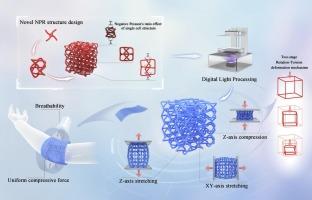Towards understanding the design principle and rotation deformation mechanics of 3D chiral NPR structure with tunable mechanical responses
IF 7.9
2区 材料科学
Q1 MATERIALS SCIENCE, MULTIDISCIPLINARY
引用次数: 0
Abstract
In this study, an innovative three-dimensional Negative Poisson’s ratio (NPR) chiral structure was designed based on a 2D staggered rib architecture. This design integrates horizontally oriented chiral alternating ribs and vertically oriented Z-shaped configurations. Two optimized architectures, namely the wave-optimized structure (W-NPR) and the node-enhanced structure (N-NPR), were proposed and compared with the original folded structure (F-NPR). Characterization analysis revealed that the N-NPR structure exhibited superior formability, making it suitable for Digital Light Processing (DLP) fabrication. A parametric study on the mechanical performance of the N-NPR structure demonstrated that an increased volume fraction enhances the mechanical properties at the expense of structural compliance. Uniaxial tensile testing along the XY-plane and Z-axis confirmed the anisotropic Young’s modulus. Experimental and finite element simulations further revealed anisotropic behavior and a unique two-stage rotation-torsion compressive deformation mechanism of N-NPR, which enables advanced mechanical designs by enhancing the degree of freedom for deformation mode conversion. This work proposes a novel method for designing 3D NPR structures and elucidates its mechanical deformation mechanism, enabling transformative advances in aerospace, personalized healthcare, and adaptive wearable technologies.

探讨具有可调力学响应的三维手性NPR结构的设计原理和旋转变形机理
本文在二维交错肋结构的基础上,设计了一种新颖的三维负泊松比(NPR)手性结构。该设计集成了水平方向的手性交替肋和垂直方向的z形结构。提出了两种优化结构,即波优化结构(W-NPR)和节点增强结构(N-NPR),并与原始折叠结构(F-NPR)进行了比较。表征分析表明,N-NPR结构具有良好的成形性,适合于数字光处理(DLP)制造。对N-NPR结构力学性能的参数化研究表明,体积分数的增加以牺牲结构顺应性为代价提高了力学性能。沿xy平面和z轴的单轴拉伸试验证实了杨氏模量的各向异性。实验和有限元模拟进一步揭示了N-NPR的各向异性行为和独特的两阶段旋转-扭转压缩变形机制,通过提高变形模式转换的自由度,为先进的机械设计提供了可能。这项工作提出了一种设计3D NPR结构的新方法,并阐明了其机械变形机制,从而实现了航空航天、个性化医疗保健和自适应可穿戴技术的变革性进步。
本文章由计算机程序翻译,如有差异,请以英文原文为准。
求助全文
约1分钟内获得全文
求助全文
来源期刊

Materials & Design
Engineering-Mechanical Engineering
CiteScore
14.30
自引率
7.10%
发文量
1028
审稿时长
85 days
期刊介绍:
Materials and Design is a multi-disciplinary journal that publishes original research reports, review articles, and express communications. The journal focuses on studying the structure and properties of inorganic and organic materials, advancements in synthesis, processing, characterization, and testing, the design of materials and engineering systems, and their applications in technology. It aims to bring together various aspects of materials science, engineering, physics, and chemistry.
The journal explores themes ranging from materials to design and aims to reveal the connections between natural and artificial materials, as well as experiment and modeling. Manuscripts submitted to Materials and Design should contain elements of discovery and surprise, as they often contribute new insights into the architecture and function of matter.
 求助内容:
求助内容: 应助结果提醒方式:
应助结果提醒方式:


